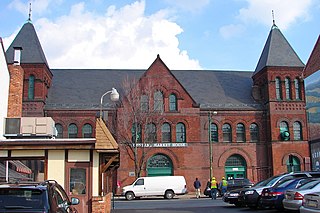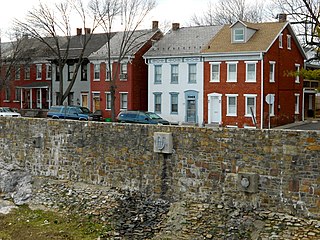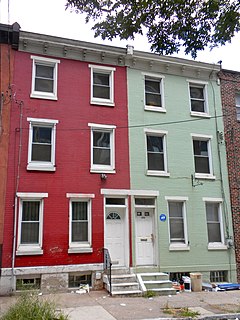
The Washington Park Historic District is a national historic district located in Indianapolis, Indiana. It was listed on the National Register of Historic Places on June 24, 2008. It comprises nearly 60 acres (240,000 m2) and is located 4 miles (6.4 km) north of downtown Indianapolis, in the south-central part of the Meridian-Kessler neighborhood. The district includes all properties south of 43rd Street and north of 40th Street, and west of Central Avenue and east of the alley running north and south between Pennsylvania and Meridian Streets; Washington Boulevard runs north-south through the center of the district. It includes 110 contributing buildings, ranging mostly from mansions to small bungalows, and three non-contributing buildings.

East Campus is a neighborhood of Columbia, Missouri directly east of the University of Missouri and downtown Columbia. The area contains historic residential property as well many Greek student organizations houses. The district contains parts of Stephens College, the Boone Hospital Center's campus and the historic Lee Street Deli. It developed between about 1895 and 1945, and includes representative examples of Tudor Revival, Colonial Revival, and Bungalow / American Craftsman style architecture.

The Awbury Historic District is a historic area in the East Germantown neighborhood of Philadelphia, Pennsylvania. It encompasses the former summer homes and farms of the extended Cope family, who moved to the area starting in 1849 and the entire Awbury Arboretum, which occupies most of the district's area, as well as adjacent properties developed and occupied by Henry Cope (1793-1865), son and successor to prominent Philadelphia Orthodox Quaker merchant Thomas Pym Cope (1768-1854), his close relatives, and his descendants. The district, which has been described by Philadelphia area historians as "visually distinct from the densely-built urban blocks that surround it on three sides, and from the level, open landscape of the city park to the northwest," features buildings which were designed in the Gothic Revival, Italian Villa, Queen Anne, Tudor Revival, Shingle, and Colonial Revival styles of architecture between 1849 and 1922.

Moxham Historic District is a national historic district located at Johnstown in Cambria County, Pennsylvania. The district includes 330 contributing buildings in a predominantly residential area in southern Johnstown. There are 315 contributing dwellings, 17 former carriage house / horse barns, 21 commercial buildings, 10 churches, and one former school. The district includes five contributing buildings dated before the Johnstown Flood, but the majority date from 1890 to 1930. The dwellings include notable examples of popular architectural styles including Bungalow/craftsman, Colonial Revival, and American Foursquare. Notable non-residential buildings include St. Patrick's Catholic Church (1905), former Calvary Methodist Church (1894), Allegheny Wesleyan Methodist Church (1898), Grove Avenue Methodist Church (1902), Second Presbyterian Church (1914), and former Cypress Avenue School (1900).

York Historic District is a national historic district located in the central business district and surrounding residential areas of York in York County, Pennsylvania. It is north of the Springdale Historic District. The district includes 309 contributing buildings and includes notable examples of the Late Victorian and Classical Revival styles. Notable buildings include the Christ Lutheran Church (1812–1814), Odd Fellows Hall (1850), U.S. Post Office (1911), Strand and Capitol Theatre (1923–1925), Elks Home (1860s), Pullman Factory Building, Sylvia Newcombe Center (1892), Friends Meeting House (1766–1783), William C. Goodridge house (1827), Otterbein United Methodist Church (1869), St. John's Episcopal Church (1765), Lafayette Club (1839), National Hotel (1828–1863), Bon Ton (1911), Smyser-Bair House (1830s), and Pennsylvania Central Railroad Station (1880s). Located in the district and separately listed are the Barnett Bobb House and Gen. Horatio Gates House and Golden Plough Tavern.

Fairmount Historic District is a national historic district located in the Fairmount neighborhood of York in York County, Pennsylvania. The district includes 101 contributing buildings and 1 contributing site in a residential area of York. The neighborhood was developed between 1889 and about 1915, and includes notable examples of the Queen Anne and Second Empire styles.
Northwest York Historic District is a national historic district located in the Northwest York neighborhood of York in York County, Pennsylvania. The district includes 815 contributing buildings, 1 contributing site, and 1 contributing structure in a residential area of York. The neighborhood was developed between 1882 and 1930, and includes notable vernacular examples of various Late Victorian styles, Colonial Revival, and American Foursquare.

North Wayne Historic District is a national historic district located at Wayne, Delaware County, Pennsylvania. The district includes 190 contributing buildings in a residential area of Wayne. The contributing dwellings were built between 1881 and 1925, and include notable examples of Shingle Style and Colonial Revival architecture. The district also reflects suburban development in the late-19th century as it was a major component of a large, planned, railroad commuter suburb called "Wayne Estate." It is located north of the South Wayne Historic District.

Brownsville Northside Historic District is a national historic district located adjacent to the Brownsville Commercial Historic District at Brownsville, Fayette County, Pennsylvania. The district includes 188 contributing buildings and 2 contributing sites in a neighborhood of Brownsville. Most of the contributing buildings are residential, with some commercial buildings and nine churches. The house styles are reflective of a number of popular 19th- and early-20th-century architectural styles including Colonial Revival, Bungalow / American Craftsman, and Greek Revival. The oldest building is Brashear's Tavern, and there are five buildings that date between 1815 and 1840. The contributing sites are cemeteries associated with two of the churches. Located in the district and separately listed are the St. Peter's Church and Bowman's Castle.

Oak Park Historic District is a national historic district located in Hatfield Township, Montgomery County, Pennsylvania. It encompasses 33 contributing buildings and 1 contributing structure dated from 1912 to the 1980s in a planned residential neighborhood. The residences reflect a variety of popular late 19th- and 20th-century architectural styles including Bungalow / American Craftsman, cottage revival, and Colonial Revival. The contributing structure is the entry gate to the suburban development.

Oil City North Side Historic District, also known as Cottage Hill, Palace Hill, and Polish Hill, is a national historic district located at Oil City, Venango County, Pennsylvania. It is directly north of the Oil City Downtown Commercial Historic District. The district includes 1,140 contributing buildings in a predominantly residential section of Oil City. It includes a few neighborhood commercial buildings, churches, and two schools. The houses were built between about 1870 and 1945 and are in a variety of popular architectural styles including Romanesque Revival, Queen Anne, Second Empire, Colonial Revival, Classical Revival, and Italianate. It also includes a number of working class vernacular dwellings, especially in the Polish Hill section.

Honesdale Residential Historic District, is a national historic district located at Honesdale, Wayne County, Pennsylvania. The district includes 289 contributing buildings and 5 contributing sites in a predominantly residential neighborhood of Honesdale. The residences were built between 1830 and 1940, in a variety of popular architectural styles including Greek Revival, Italianate, Bungalow / American Craftsman, Colonial Revival, Second Empire, Queen Anne. The larger homes are typically 2+1⁄2-story, wood-frame dwellings with hipped and gable roofs. The district also includes some former factories, such as the Irving Cut Glass Co. and Honesdale Show Company, and a former Armory. The contributing sites consist of four cemeteries and Riverside Park.

James R. Ludlow School is a historic K-8 elementary school within the School District of Philadelphia, located in the Yorktown neighborhood of Philadelphia, Pennsylvania.

Bayard Taylor School is a historic elementary school located in the Hunting Park neighborhood of Philadelphia, Pennsylvania. It is part of the School District of Philadelphia. The building was designed by Henry deCourcy Richards and built in 1907–1908. It is a three-story, seven bay, brick building with a raised basement in the Colonial Revival / Late Gothic Revival-style. It features an ornate entrance pavilion, stone detailing, and a brick parapet. The school was named for poet and author Bayard Taylor (1825–1878).

Andrew J. Morrison School is a historic school located in the Olney neighborhood of Philadelphia, Pennsylvania. It functions as a K–8 school under the School District of Philadelphia. The building was designed by Irwin T. Catharine and built in 1922–1924. It is a three-story, red brick building on a raised basement in a Late Gothic Revival / Tudor Revival-style. It features carved stone decorative panels and a projecting two-story stone bay.

William S. Peirce School is a historic school building located in the Southwest Center City neighborhood of Philadelphia, Pennsylvania. It was designed by Irwin T. Catharine and built in 1928–1929. It is a four-story, nine bay, brick building on a raised basement in the Late Gothic Revival-style. It features pilasters with limestone caps and a projecting entrance pavilion with an arched opening.

Girard Avenue Historic District is a national historic district located in the Cabot neighborhood of Philadelphia, Pennsylvania. It encompasses 137 contributing buildings. They were largely built in the mid- to late-19th century and consist of residential, commercial, and industrial properties. The residential buildings include blocks of 19th century speculative rowhouses. Residential buildings include notable examples of the Greek Revival, Late Victorian, and Beaux Arts styles. Notable non-residential buildings include the Church of the Gesú (1879), designed by Edwin Forrest Durang, and Northwestern National Bank (1886).

Springdale Historic District is a national historic district located in New Hope, Bucks County, Pennsylvania. The district includes 29 contributing buildings in a rural industrial area in the borough of New Hope. Notable buildings include the Heath House / Huffnagle-Hood Mansion and grist mill, James Magill House (1790), three-story stone textile mill, Conrad Hartman Store, and small single-family dwellings for black and unskilled laborers.

Jefferson Historic District is a national historic district located at Lafayette, Tippecanoe County, Indiana. The district encompasses 161 contributing buildings, 2 contributing sites, and 22 contributing structures in a predominantly residential section of Lafayette. It developed between about 1853 and 1951 and includes representative examples of Italianate, Greek Revival, and Bungalow / American Craftsman style architecture. Notable contributing resources include the Deutsche Evangelische Kirche (1905), Isador Metzger House, Hubert Gilmartin House, B.F. Biggs Pump Factory Building, Deutsche Methodist Kirche (1885), Herman & Mary Fletemeyer House, Mohr House, Warrenberg-Reule Double House, Alfred Gaddis House, Wabash Valley House (1862), Haywood Tag Company Building (1928), and Jefferson High School (1927).

The Camp Harlan-Camp McKean Historic District, also known as the Hugh B. and Mary H. Swan Farmstead and the Springdale Stock Farm, is a nationally recognized historic district located northwest of Mount Pleasant, Iowa, United States. It was listed on the National Register of Historic Places in 2013. At the time of its nomination it consisted of eight resources, which includes two contributing buildings, one contributing site, one contributing object and four non-contributing buildings.























